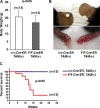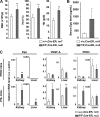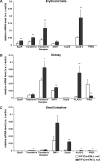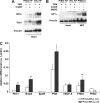Somatic inactivation of the PHD2 prolyl hydroxylase causes polycythemia and congestive heart failure
- PMID: 18096761
- PMCID: PMC2265460
- DOI: 10.1182/blood-2007-10-117812
Somatic inactivation of the PHD2 prolyl hydroxylase causes polycythemia and congestive heart failure
Abstract
Pharmacologic activation of the heterodimeric HIF transcription factor appears promising as a strategy to treat diseases, such as anemia, myocardial infarction, and stroke, in which tissue hypoxia is a prominent feature. HIF accumulation is normally linked to oxygen availability because an oxygen-dependent posttranslational modification (prolyl hydroxylation) marks the HIFalpha subunit for polyubiquitination and destruction. Three enzymes (PHD1, PHD2, and PHD3) capable of catalyzing this reaction have been identified, although PHD2 (also called Egln1) appears to be the primary HIF prolyl hydroxylase in cell culture experiments. We found that conditional inactivation of PHD2 in mice is sufficient to activate a subset of HIF target genes, including erythropoietin, leading to striking increases in red blood cell production. Mice lacking PHD2 exhibit premature mortality associated with marked venous congestion and dilated cardiomyopathy. The latter is likely the result of hyperviscosity syndrome and volume overload, although a direct effect of chronic, high-level HIF stimulation on cardiac myocytes cannot be excluded.
Figures







Similar articles
-
Regulation of adult erythropoiesis by prolyl hydroxylase domain proteins.Blood. 2008 Mar 15;111(6):3229-35. doi: 10.1182/blood-2007-09-114561. Epub 2007 Dec 4. Blood. 2008. PMID: 18056838 Free PMC article.
-
Hypoxia-inducible factor-1 (HIF-1) promotes its degradation by induction of HIF-alpha-prolyl-4-hydroxylases.Biochem J. 2004 Aug 1;381(Pt 3):761-7. doi: 10.1042/BJ20040620. Biochem J. 2004. PMID: 15104534 Free PMC article.
-
A feedback loop involving the Phd3 prolyl hydroxylase tunes the mammalian hypoxic response in vivo.Mol Cell Biol. 2009 Nov;29(21):5729-41. doi: 10.1128/MCB.00331-09. Epub 2009 Aug 31. Mol Cell Biol. 2009. PMID: 19720742 Free PMC article.
-
Involvement of oxygen-sensing pathways in physiologic and pathologic erythropoiesis.Blood. 2009 Sep 3;114(10):2015-9. doi: 10.1182/blood-2009-05-189985. Epub 2009 Jun 3. Blood. 2009. PMID: 19494350 Review.
-
HIF-prolyl hydroxylases and cardiovascular diseases.Toxicol Mech Methods. 2012 Jun;22(5):347-58. doi: 10.3109/15376516.2012.673088. Toxicol Mech Methods. 2012. PMID: 22424133 Review.
Cited by
-
Regulation of erythropoiesis by hypoxia-inducible factors.Blood Rev. 2013 Jan;27(1):41-53. doi: 10.1016/j.blre.2012.12.003. Epub 2013 Jan 3. Blood Rev. 2013. PMID: 23291219 Free PMC article. Review.
-
Pharmacological HIF2α inhibition improves VHL disease-associated phenotypes in zebrafish model.J Clin Invest. 2015 May;125(5):1987-97. doi: 10.1172/JCI73665. Epub 2015 Apr 13. J Clin Invest. 2015. PMID: 25866969 Free PMC article.
-
New Insights into Protein Hydroxylation and Its Important Role in Human Diseases.Biochim Biophys Acta. 2016 Dec;1866(2):208-220. doi: 10.1016/j.bbcan.2016.09.004. Epub 2016 Sep 20. Biochim Biophys Acta. 2016. PMID: 27663420 Free PMC article. Review.
-
Signaling hypoxia by hypoxia-inducible factor protein hydroxylases: a historical overview and future perspectives.Hypoxia (Auckl). 2014 Dec 5;2:197-213. doi: 10.2147/HP.S47598. eCollection 2014. Hypoxia (Auckl). 2014. PMID: 27774477 Free PMC article. Review.
-
The role of α-ketoglutarate and the hypoxia sensing pathway in the regulation of pancreatic β-cell function.Islets. 2020 Sep 2;12(5):108-119. doi: 10.1080/19382014.2020.1802183. Epub 2020 Sep 2. Islets. 2020. PMID: 32876527 Free PMC article. Review.
References
-
- Schofield CJ, Ratcliffe PJ. Oxygen sensing by HIF hydroxylases. Nat Rev Mol Cell Biol. 2004;5:343–354. - PubMed
-
- Kaelin WG., Jr The von Hippel-Lindau protein, HIF hydroxylation, and oxygen sensing. Biochem Biophys Res Commun. 2005;338:627–638. - PubMed
-
- Koivunen P, Hirsila M, Gunzler V, Kivirikko KI, Myllyharju J. Catalytic properties of the asparaginyl hydroxylase (FIH) in the oxygen sensing pathway are distinct from those of its prolyl 4-hydroxylases. J Biol Chem. 2004;279:9899–9904. - PubMed
-
- Bracken CP, Fedele AO, Linke S, et al. Cell-specific regulation of hypoxia-inducible factor (HIF)-1alpha and HIF-2alpha stabilization and transactivation in a graded oxygen environment. J Biol Chem. 2006;281:22575–22585. - PubMed
-
- Dayan F, Roux D, Brahimi-Horn MC, Pouyssegur J, Mazure NM. The oxygen sensor factor-inhibiting hypoxia-inducible factor-1 controls expression of distinct genes through the bifunctional transcriptional character of hypoxia-inducible factor-1alpha. Cancer Res. 2006;66:3688–3698. - PubMed
Publication types
MeSH terms
Substances
Grants and funding
LinkOut - more resources
Full Text Sources
Other Literature Sources
Medical
Molecular Biology Databases

